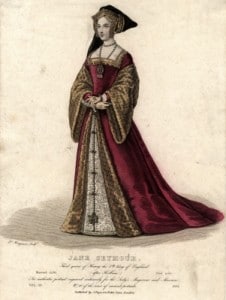 On this day in 1536, Henry VIII married his third wife, Jane Seymour, in the Queen’s Closet at York Place. This marriage took place just 11 days after the execution of Henry’s second wife, Anne Boleyn, and was kept secret for a few days. Henry even went as far to ask his council to request that he should remarry in the best interests of the country, to provide England with an heir, yet he was actually already married to Jane! His council, who were already “in the know”, heard the King’s request and his praise of a certain Jane Seymour and responded by saying “let your majesty do as you desire. We all consider her a worthy maiden, and we hope in God that your union will be fruitful and happy.”1
On this day in 1536, Henry VIII married his third wife, Jane Seymour, in the Queen’s Closet at York Place. This marriage took place just 11 days after the execution of Henry’s second wife, Anne Boleyn, and was kept secret for a few days. Henry even went as far to ask his council to request that he should remarry in the best interests of the country, to provide England with an heir, yet he was actually already married to Jane! His council, who were already “in the know”, heard the King’s request and his praise of a certain Jane Seymour and responded by saying “let your majesty do as you desire. We all consider her a worthy maiden, and we hope in God that your union will be fruitful and happy.”1
Mixed Feelings
While I don’t see Jane Seymour as a meek, demure woman who just happened to catch the King’s attention, I also do not see her as a woman without any feelings. I can imagine Jane’s inner turmoil as she married a King who had treated one wife, and his daughter, with atrocious cruelty and who had entertained Jane while his second wife was executed.
Henry VIII was also past his prime by now and was far from the “virtuous prince” who inherited the throne in 1509. He was overweight, was suffering with a nasty leg injury, and had become quite a tyrant. In her book “Jane Seymour: Henry VIII’s True Love”, Elizabeth Norton writes of how Henry VIII was, at this time, close to “the tyrant described by Marillac, the French ambassador, in 1540”2 and that Marillac described Henry as having three vices: covetousness, distrust and fear, and inconstancy. He was not exactly perfect husband material and that surely must have worried Jane. It is no wonder that Jane presented herself as the meek, subserviant wife and queen and that she chose “Bound to Obey and Serve” as her motto, it was about painting herself as the complete opposite of Anne Boleyn and it was also about her survival. A clever woman methinks!
A Legend
When I was at Hampton Court Palace recently I heard the legend that although Jane Seymour is buried in St George’s Chapel at Windsor Castle, her heart is actually buried under the altar in the Chapel Royal at Hampton Court Palace. Interesting!
Notes
- Jane Seymour: Henry VIII’s True Love by Elizabeth Norton, page 81
- Ibid., pages 77-78
Further Reading
You can read more about Jane Seymour in my article “Jane Seymour” and I would also highly recommend Elizabeth Norton’s book Jane Seymour: Henry VIII’s True Love. I will leave you with a video on Jane.